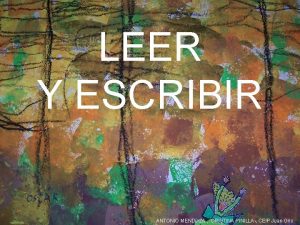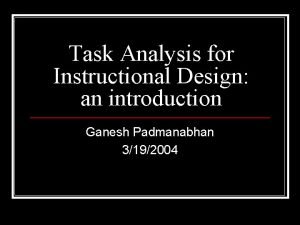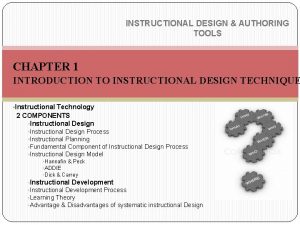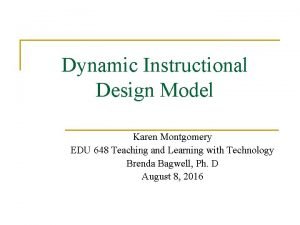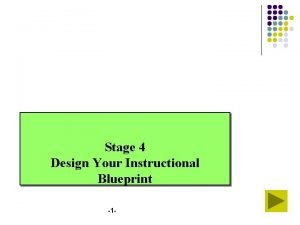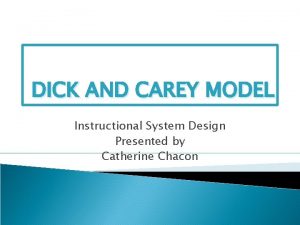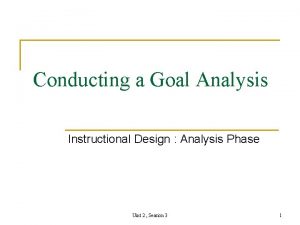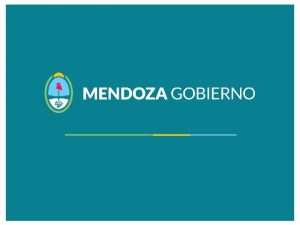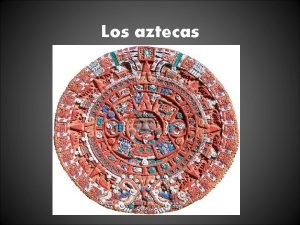Instructional Design Antonio Mendoza Instructional Design I understand












- Slides: 12

Instructional Design Antonio Mendoza

Instructional Design I understand instructional design as a process that educators go through while creating lesson plans in order to make the learning process more obtainable by all students. Furthermore, it allows all students the opportunity to be engaged in the learning process, thereby making the instruction more effective.

Instructional Design Theory Learning Theory Instructional Design Model These three theories and models are similar in that they each focus on what the instructor is doing in order for the learner to be able to achieve academic success. They each have multiple aspects and opportunities for the learner to succeed. They differ in their approach to reaching the learner. Instructional Design Theory focuses on what the instructor does before the lesson, throughout the lesson, and following the lesson. Learning Theory focuses more on how the learner obtains the desired information and Instructional Design Model is more of a model than an implementation process.

Instructional Design There are many different instructional design models from which to choose. Many of these models have common features such as… Ø Ø Structure Phases Application Engagement Ø Ø Tasks Design Instruction Cognitive Thinking

Instructional Design Dick and Carey

Instructional Design ADDIE

Analysis is the first phase in the ADDIE model and is where the instructional problem is clarified. This generally is the beginning portion of instructional design and is where the educator or instructor establishes the lessons goals and objectives. Once these have been established, the learner can then express any schema (prior knowledge) that they may possess in the content matter.

Design is the second phase in the ADDIE model and contains the core aspects of the instructional design process. This portion of the process involves the instruction intentionally thinking about the lesson and how best to implement it. Generally, the instructor contemplates aspects of the lesson such as goals and objectives, content, and additional media. These aspects, along with others at times, lead into the development portion of this model.

Development In the development portion of the ADDIE model, instructors put together the content that will be included within the lesson. As educators, the development process involves deciding on what type of content to use and where to obtain it from. This could include multi-media, manipulatives, resources, and or textual information.

Implementation The implementation portion of the ADDIE model is when the instructor actually puts all of the previous processes into action. For educators, this is the actual lesson that is given to the learner. All previous aspects of the model should come into play at some point during this phase of the learning theory model.

Evaluation During the evaluation phase, the educator, or facilitator, gives an assessment of the lesson. Upon completion, they examine and evaluate the effectiveness of the instruction and decide whether further instruction is needed.

Why Use Instructional Design As educators, we use instructional design as a way of intentionally planning, and ultimately meeting the diverse needs of the learner. As the saying goes, “failing to plan, is planning to fail. ” The same is true for instruction, without a plan, our students are in serious danger of not succeeded. However, if we implement proper instructional design, we will not only better meet the diverse needs of the learner, but will achieve greater success with our students.
 Grafismos primitivos
Grafismos primitivos To understand recursion you must understand recursion
To understand recursion you must understand recursion Task analysis instructional design
Task analysis instructional design Systematic design model by robert diamond
Systematic design model by robert diamond Instructional design authoring tools
Instructional design authoring tools Dynamic instructional design
Dynamic instructional design Strengths and weaknesses of assure model
Strengths and weaknesses of assure model Instructional design blueprint template
Instructional design blueprint template Seels ve glasgow modeli
Seels ve glasgow modeli Kemp design model
Kemp design model Scaffolding instructional design
Scaffolding instructional design Dick and carey design model
Dick and carey design model Goal analysis instructional design
Goal analysis instructional design
